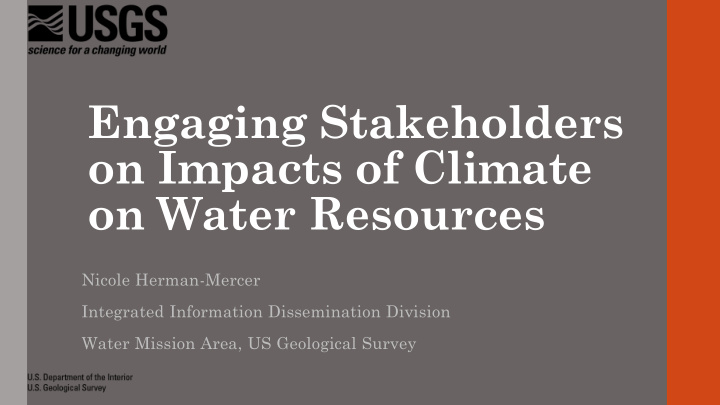



Engaging Stakeholders on Impacts of Climate on Water Resources Nicole Herman-Mercer Integrated Information Dissemination Division Water Mission Area, US Geological Survey
Who is a Stakeholder? • Individuals, groups or organizations affected by ( or who can affect) a decision or action. • Stakeholders will vary in their interest, power and responsibility with regard to a particular issue. Federal • They will have different roles and responsibilities Gov’t • They will produce and be informed by different modes of knowledge State Gov’t Local Gov’t Tribal Nations
What is Engagement? Participation Communication Partnerships Consultation
Continuum of Engagement Co- Productio n Partnershi p Participatio Co-Production n Consultatio n Communicatio n
Yukon River Inter-Tribal Watershed Council – A Stakeholder Group The USGS serves the Nation by providing reliable scientific information To restore & protect the Yukon River to describe and understand the Earth; minimize loss of life and property from Fifty year vision: natural disasters; manage water, “To once again drink water directly biological, energy, and mineral from the Yukon as our ancestors did for resources; and enhance and protect our thousands of years before us ” quality of life.
Jon Waterhouse - YRITWC Alaska (US) Director, Paul Schuster – USGS Research Hydrologist, Rob Rosenburg - YRITWC Yukon Territory (CA) Director Founded in 1997 as a coalition of sovereign Tribal & First Nation governments…today it represents 75 of the 76 Tribes and First Nations in the watershed. Suzette Kimball – USGS Director, Clarence Alexander – Co-Chair, Alaska, Carol Sidney Co- Chair Yukon Territory
Community-Based Water-Quality Monitoring Communication Annual Training Sample Sample Analysis Shipment Data Sharing & Dissemination Bi-Weekly Sampling
Striving for Co-Production Workshop participants
Towards Co-Production School outreach & student data collection.
Towards Co-Production Community dinner
Towards Co-Production Participatory Methods • Semi-structured Interviews – flexible enough to be guided by the participants knowledge & interest • Participatory Mapping – group activity locating subsistence areas
Towards Co-Production Soliciting Feedback • Gave a presentation in each community – preliminary results • Asked for feedback – What did we get right? What did we get wrong?
Dissemination USGS Fact Sheet • Presentations • Publications •
What was gained Benefits of engaging stakeholders: • Democratizing science …citizen participation is citizen power… • Holistic information – the inclusion of stakeholder knowledge makes our science better. • Capacity building – transfer of knowledge and skills, capacity to do the science/monitoring without us
Acknowledgements • All of the community technicians that participate in water-quality monitoring. In particular – Cynthia Paniyak & Deborah Friday-Aguchak (Chevak Traditional Council), Victor Tonuchuk Jr & Tanya Hunt (Kotlik Tribal Council), Jay Hootch (Yupiit of Andreafksy), Robert Meyers (Pilot Station Tribal Council). • Paul F Schuster (USGS), Kelly Elder (US Forest Service) Melinda Laituri (Colorado State University), Edda Mutter (YRITWC), Ryan Toohey (USGS), Elli Matkin (YRITWC), Maggie Massey (YRITWC) Nicole Herman-Mercer nhmercer@usgs.gov 303-236-5031
Recommend
More recommend